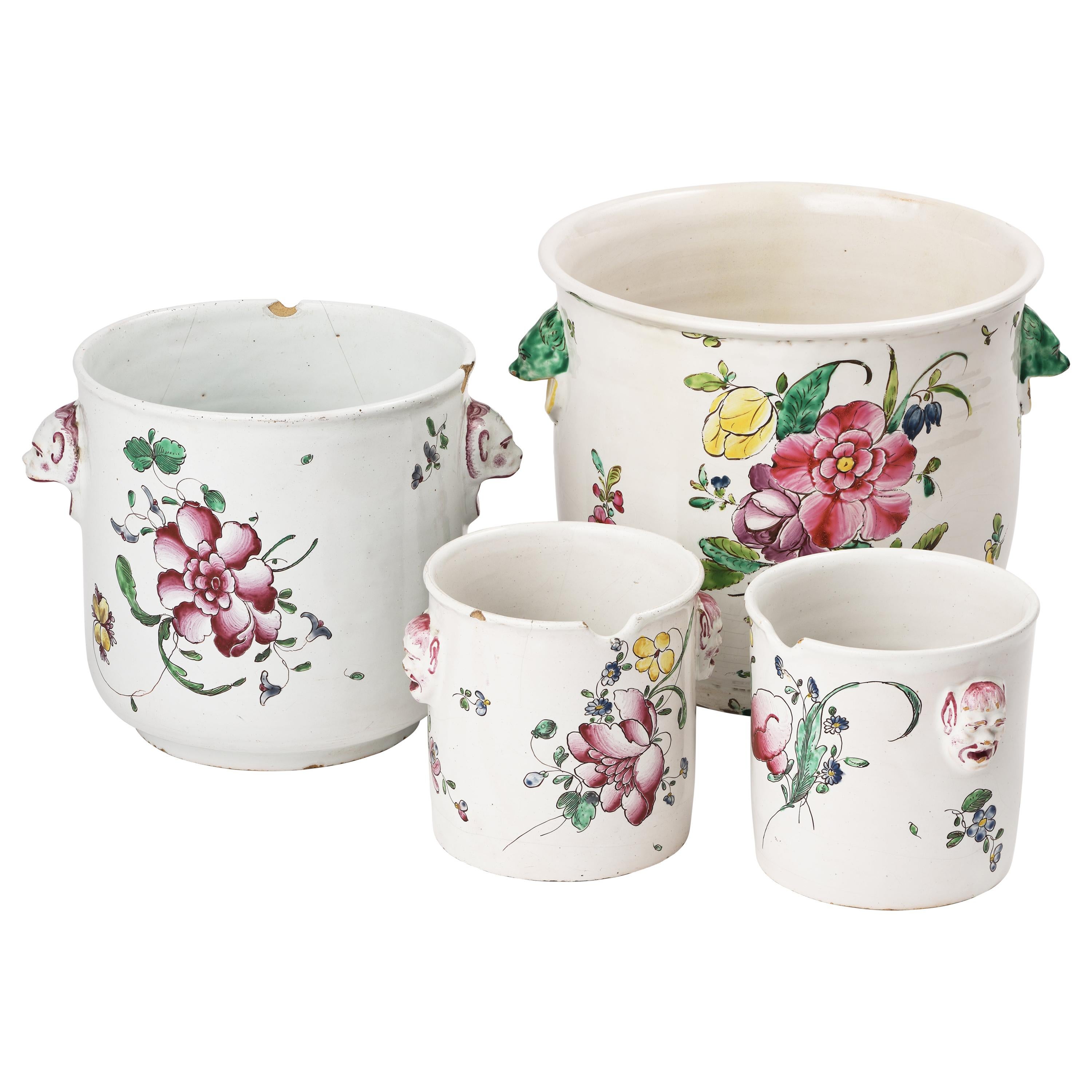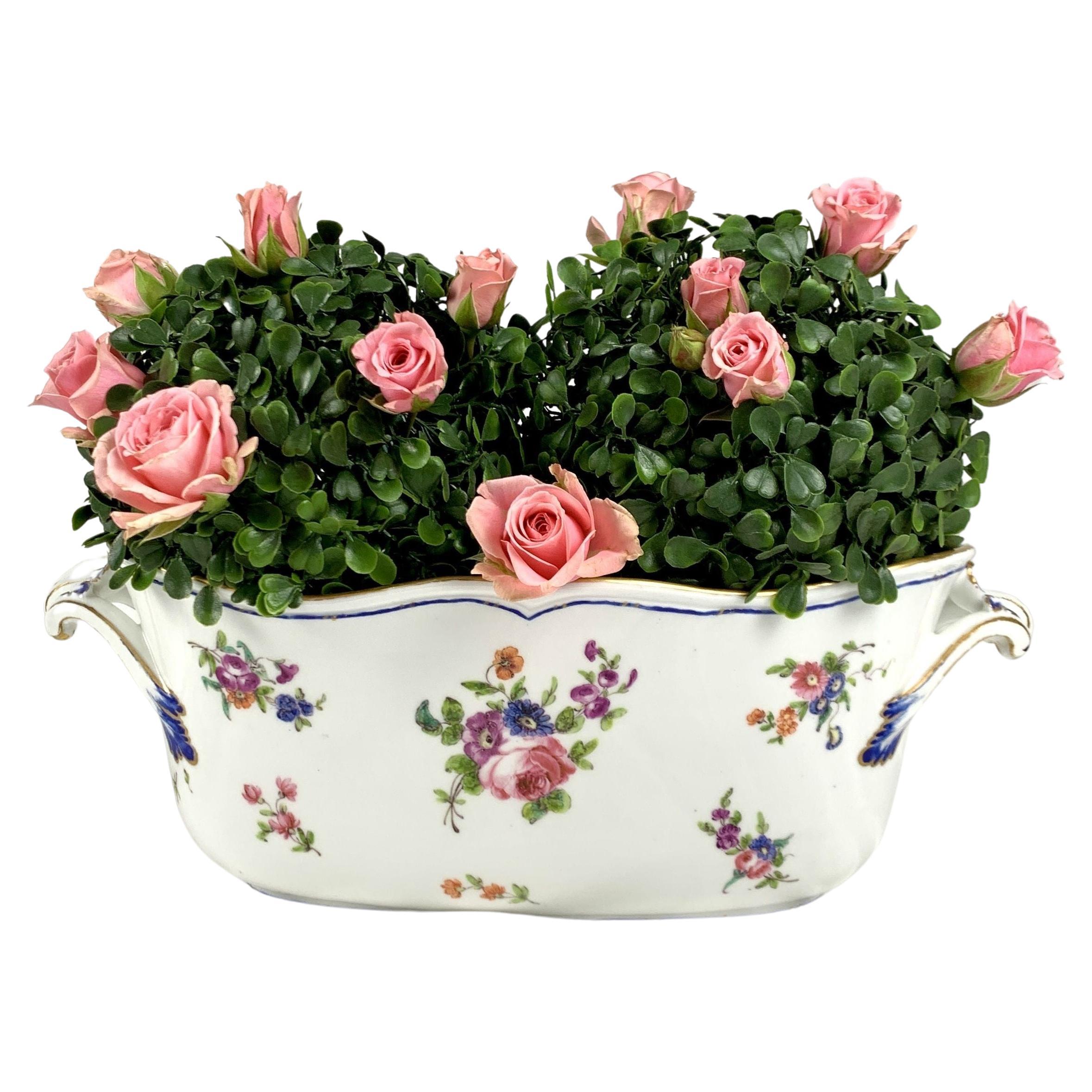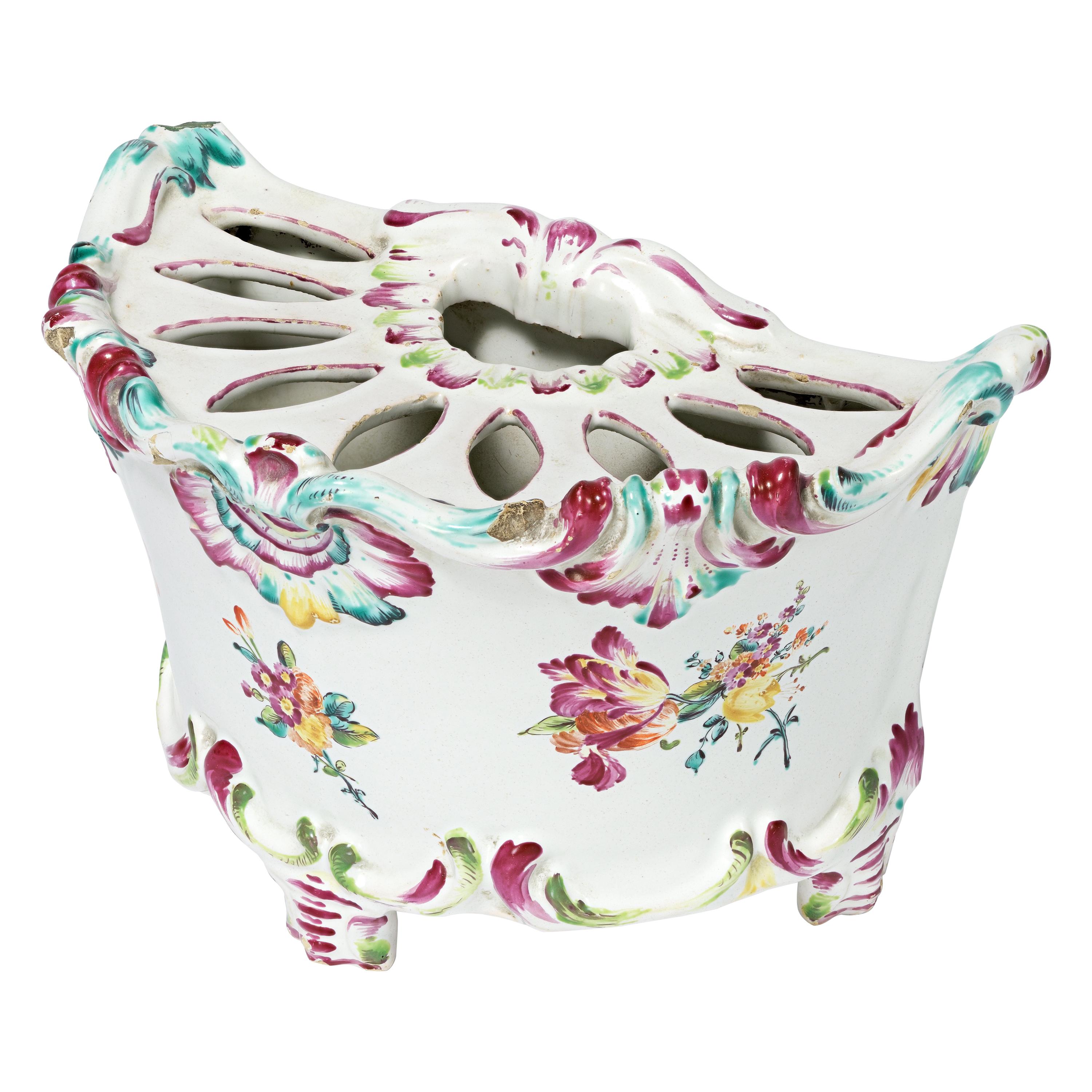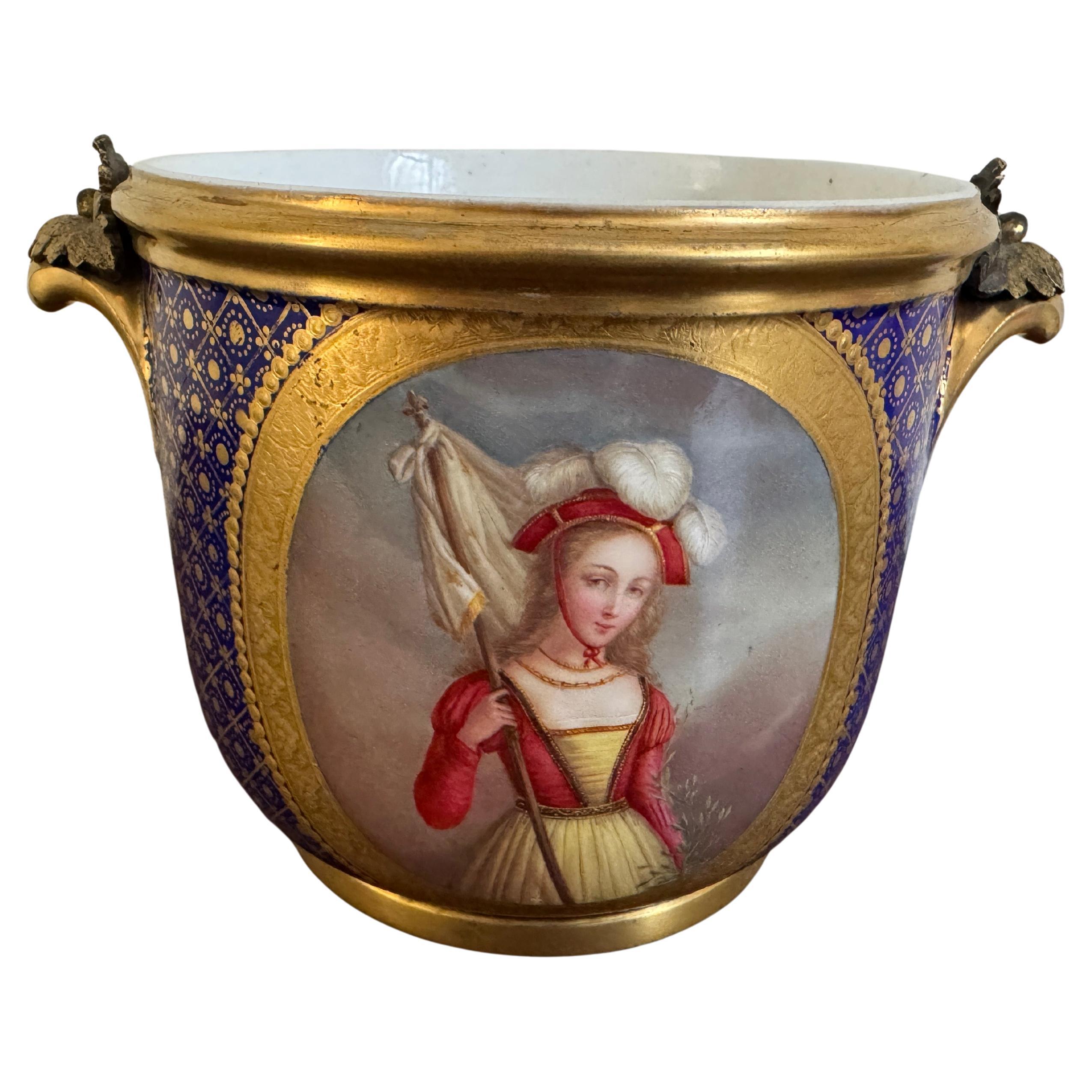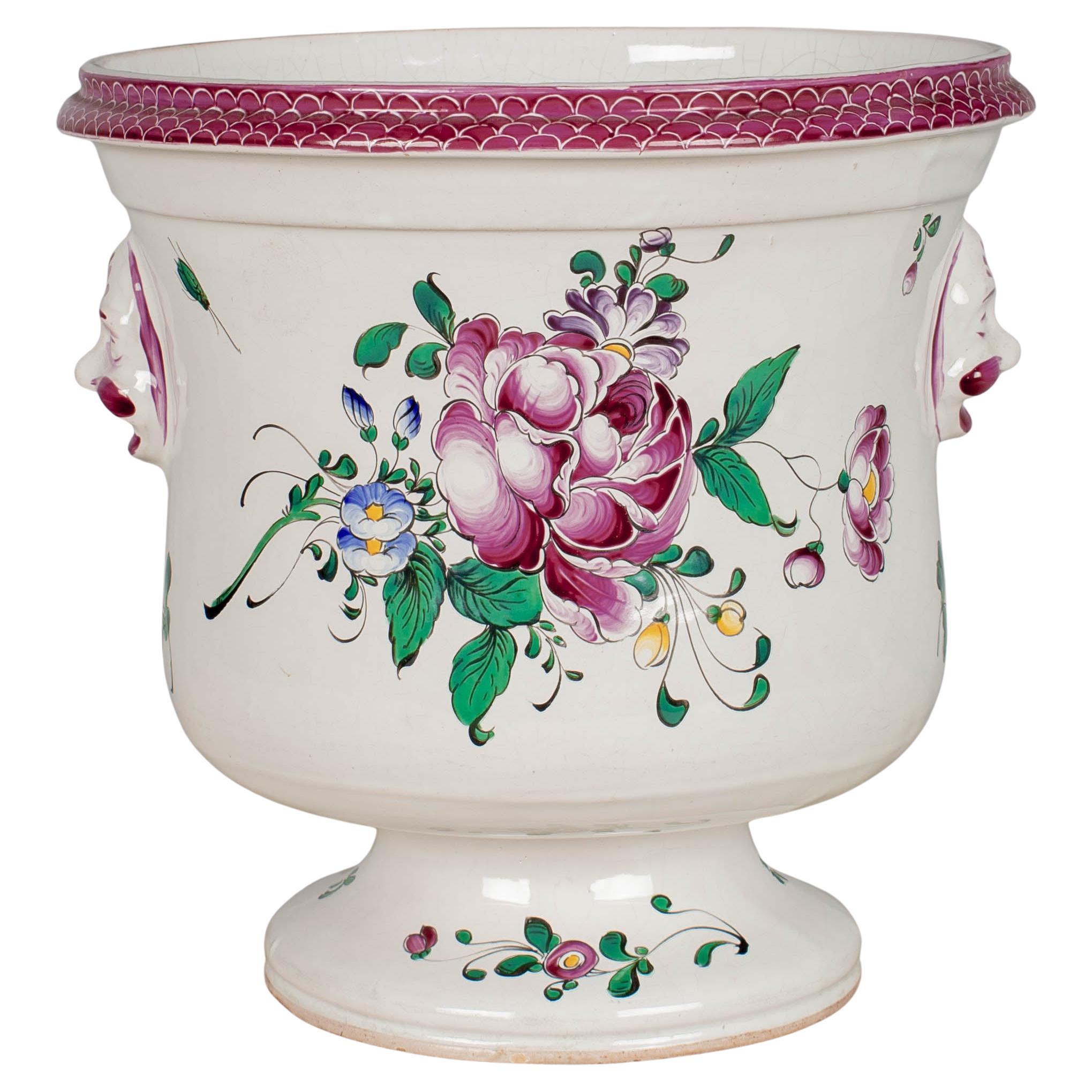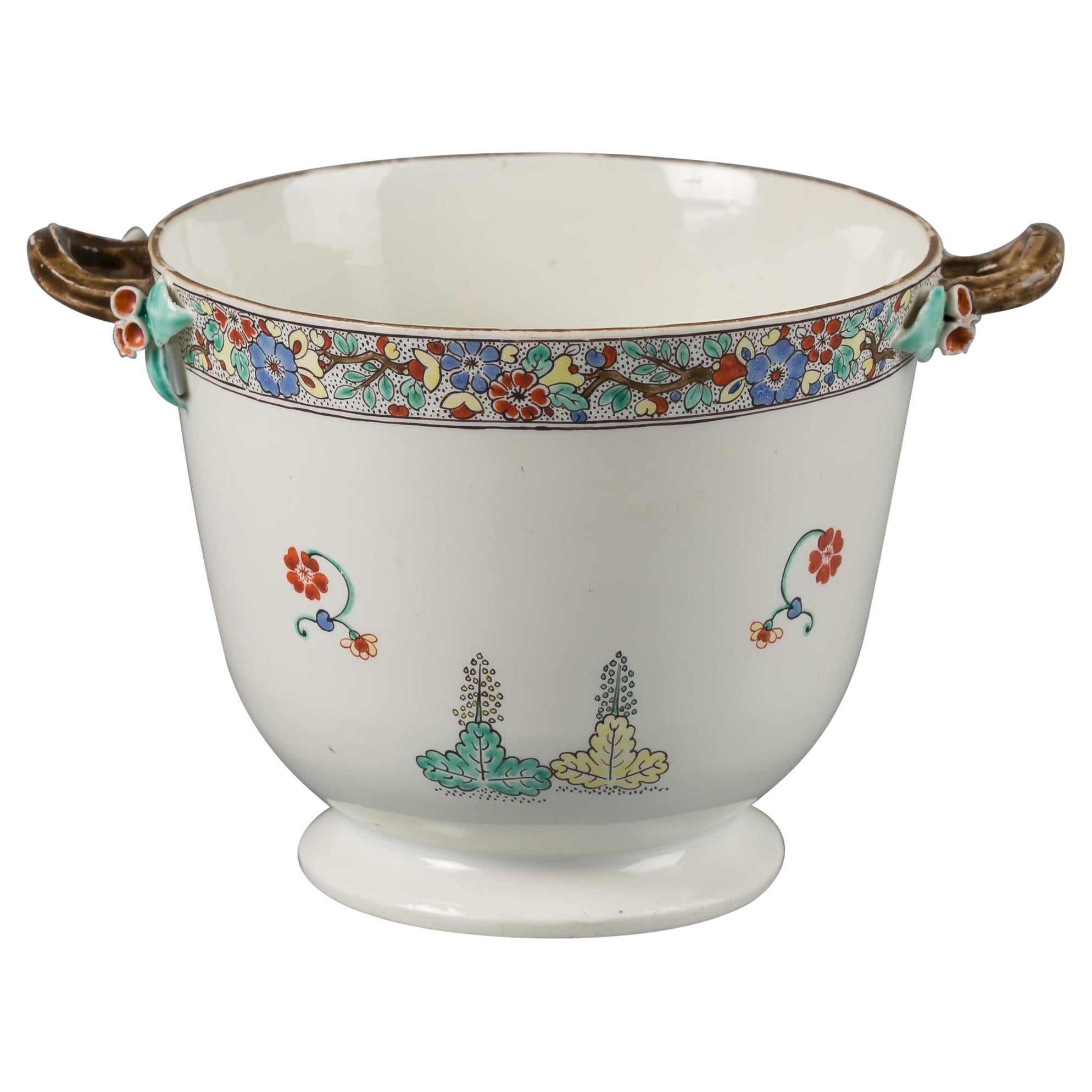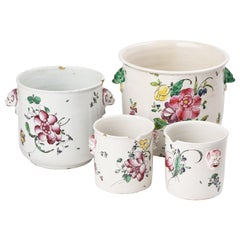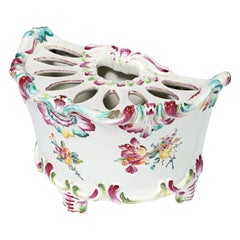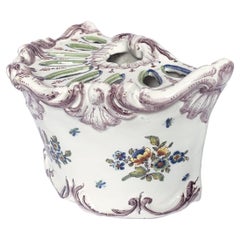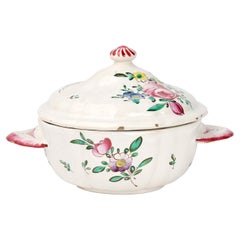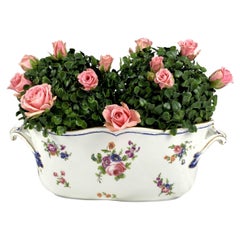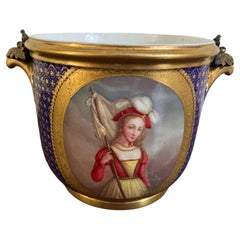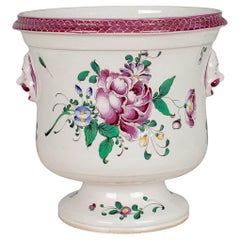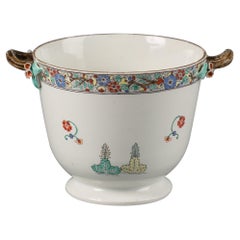Items Similar to Maiolica Bottle Cooler Joseph Hannong, Strasbourg France, circa 1771
Video Loading
Want more images or videos?
Request additional images or videos from the seller
1 of 19
Maiolica Bottle Cooler Joseph Hannong, Strasbourg France, circa 1771
$2,147.24
£1,587.48
€1,800
CA$2,953.50
A$3,283
CHF 1,720.88
MX$40,093.31
NOK 21,484.14
SEK 20,212.57
DKK 13,703.37
About the Item
Bottle cooler
Manufacture Joseph Hannong
Strasbourg, France, circa 1771
Maiolica polychrome decorated “a piccolo fuoco” (third fire)
It measures 7.40 in in height x 9.64 in diameter (18.8 cm x 24.5 cm)
Weight: 3.50 lb (1.588 g)
State of condition: a slight fêlure on the bottom and a few minor chips from use restored.
The maiolica container rests on a low ring foot. It has a cylindrical shape with a smooth wall and a curved rim, following a design inspired by silverware. Handles in the shape of stirrups were applied. They were forged in rocaille style and adhere to the body.
The decoration follows classical canons and is centered around two bouquets placed on the main sides, with a larger predominant flower from which secondary branches with smaller flowers extend. In a more discreet position, additional elements such as small buds and wildflowers appear. The handles are painted in purple and indigo with touches of yellow to simulate studs.
In 1721, Charles-François Hannong, in partnership with J. Henri Wackenfedt, founded a maiolica manufacturing company in Strasbourg, which became one of the most important ceramic enterprises in France. The works from the early phase of manufacture base their decoration on a “lambrequin” model of the coeval production In Rouen. From 1740, a “gran fuoco” color palette allowed for the creation of early floral decoration with an oriental flair. Upon the death of Charles-François in 1739, the management of the factory was handed over to his son Paul-Antoine. With the technical and artistic contribution of the Löwenfinck brothers, modeler W. Lanz, and chemist J. J. Ringler, Paul-Antoine introduced the innovative technique of “third fire” and, in 1751, also began production of hard porcelain, which was later transferred to Frankenthal. From these experiments, the naturalistic decoration known as the "flower of Strasbourg" emerged. It was inspired by the works of Meissen, but Hannong interpreted and executed it according to new aesthetic standards that would achieve enormous success throughout Europe. Upon the death of Paul-Antoine Hannong in 1760, a new season began for the manufacturing company under the leadership of his son Joseph. In 1776, Joseph resumed the production of porcelain in Strasbourg. However, due to some poor business decisions, the factory eventually faced bankruptcy and closed its doors in 1779.
The naturalistic flower decoration is one of the greatest achievements of the French manufacturing industry. It was introduced by the German painter Adam Frederic de Löwenfinck, who drew inspiration from botanical models reproduced in engravings. The cooler in question belongs to this period, and its design can be found in some specific plates produced by the manufacturer around 1770.
Bibliography:
S. De Plas, Les Faiënces de Strasbourg et de L’Est de la France. Paris 1996 pp. 37-39 ;
A. Faÿ Hallé, C. Christine Lahaussois, Le Grand Livre de la faïence française, Paris- Fribourg, 1986, p. 242.
- Attributed to:Joseph Hannong (Maker)
- Dimensions:Height: 18.8 in (47.76 cm)Diameter: 24.5 in (62.23 cm)
- Style:Rococo (Of the Period)
- Materials and Techniques:Maiolica,Enameled
- Place of Origin:
- Period:1770-1779
- Date of Manufacture:circa 1771
- Condition:Repaired: A slight fêlure on the bottom and a few minor chips from use restored. Wear consistent with age and use.
- Seller Location:Milano, IT
- Reference Number:1stDibs: LU4352234556032
About the Seller
4.3
Vetted Professional Seller
Every seller passes strict standards for authenticity and reliability
Established in 1860
1stDibs seller since 2018
21 sales on 1stDibs
Associations
International Confederation of Art and Antique Dealers' Associations
- ShippingRetrieving quote...Shipping from: Milano, Italy
- Return Policy
Authenticity Guarantee
In the unlikely event there’s an issue with an item’s authenticity, contact us within 1 year for a full refund. DetailsMoney-Back Guarantee
If your item is not as described, is damaged in transit, or does not arrive, contact us within 7 days for a full refund. Details24-Hour Cancellation
You have a 24-hour grace period in which to reconsider your purchase, with no questions asked.Vetted Professional Sellers
Our world-class sellers must adhere to strict standards for service and quality, maintaining the integrity of our listings.Price-Match Guarantee
If you find that a seller listed the same item for a lower price elsewhere, we’ll match it.Trusted Global Delivery
Our best-in-class carrier network provides specialized shipping options worldwide, including custom delivery.More From This Seller
View AllAntique Italian Maiolica Coolers Pasquale Rubati Manufacture Milan, 1770 Circa
By Pasquale Rubati
Located in Milano, IT
Assortment of bottle and glass coolers in Maiolica.
Pasquale Rubati manufacture
Milan, circa 1770
Maiolica polychrome decorated “a piccolo fuoco” (third fire)
a - Bottle cooler
5.91 in x 5.91 in diameter (15 x 15 cm )
Weight: 1.86 lb (845 g)
b - Bottle cooler
6.89 x 7.87 in diameter (17,5 x 20 cm)
Weight: 2.09 lb (948 g)
c - Pair of glass-cooler vases
3.94 x 3.94 in diameter (10 x 10 cm)
Weight: 1.43 lb (650 g)
Good state of conservation:
a - some chipping from use on the edge;
a - two fêlures covered on the edge;
c - one has deep chippings on the edge and the other a subtle fêlure.
Two Majolica factories were active in Milan in the 18th century. The first, starting from 1745, was owned by Felice Clerici; the other one by Pasquale Rubati from 1756. Rubati was in competition with Felice, whose worker he had been prior to opening his own workshop. On his death in 1796, the business was continued for a few more years by his son Carlo.
Recent studies have recognized Pasquale Rubati's contribution as the creator of "Strasbourg-style" decorations with their particularly joyful depictions. This style had previously been attributed to the Lodi manufacturers. These works here, however, are a clear example of this production.
The Majolica containers have different sizes, a cylindrical shape and rest on a low foot ring. The two largest are completed by handles in the shape of a zoomorphic mask with wide open jaws, while the smaller ones have handles applied with an anthropomorphic mask.
All the works are characterized by elegant floral decoration.
The two twin glass coolers show bunches of flowers centered around a main corolla, a rose or a peony paired...
Category
Antique 1770s Italian Rococo Ceramics
Materials
Maiolica
Rococo Italian Maiolica Flower Pot Pasquale Rubati, Milano, 1770 circa
By Pasquale Rubati
Located in Milano, IT
Maiolica flower pot “a mezzaluna” with support feet
decorated with little bunches of flowers
Pasquale Rubati Factory
Milan, circa 1770
5.5 in X ...
Category
Antique 1770s Italian Rococo Ceramics
Materials
Maiolica
Maiolica flower pot "a mezzaluna," Pasquale Rubati Factory, Milan, circa 1770
By Pasquale Rubati
Located in Milano, IT
Majolica flower pot "crescent" decorated in manganese
Pasquale Rubati Factory
Milan, c. 1770
4.92 in x 8.66 in x 5,31 in
12.5 cm x 22 cm X 13.5 cm
Weight: 2.29 lb (1039 g)
State of conservation: intact with slight chipping due to use in relief parts
A rare example of a flower pot "a mezzaluna" produced by the manufactory of the refined painter Pasquale Rubati, who opened a factory in Milan in 1756 to compete with Felice Clerici...
Category
Antique 1770s Italian Rococo Ceramics
Materials
Maiolica
Italian Maiolica Cup Ferretti Lodi, circa 1770 - 1780
By Antonio Ferretti
Located in Milano, IT
Maiolica puerperal cup
Antonio Ferretti Manufacture
Lodi, Circa 1770 - 1780
Maiolica polychrome decorated “a piccolo fuoco” (third fire).
It measures: 4.3 x 6.8 x 5.3 in (11 x 17,5 x 13,5 cm)
Weight: 0.78 lb (358 g)
State of conservation: some closed pass-through fêlures on the cup, barely visible on the outside. Some use chips on the edge of the lid, two of which are more marked.
From about the mid-sixteenth century, the puerperal soup tureen or puerperal cup became one of the most popular wedding gifts in central Italy. As an auspicious symbol, it replaced the birth table (“desco da parto”) which, on the occasion of high-ranking marriages, from the thirteenth century, had been painted by famous artists, especially in Tuscany.
In France this same tureen is called "écuelle de mariée", as it is given to spouses as a sign of fertility.
During the eighteenth century this custom spread even outside Italy to all social levels. Depending on availability and rank, it was made of different materials: precious metals, maiolica, porcelain, glass, pewter, etc.
Beginning in the mid-twentieth century, the custom of this symbolic homage gradually disappeared, although famous designers such as Gio Ponti and Giuseppe Gariboldi, even as recently as the 1940s, revisited a model of a small puerperal soup bowl for the Ginori and, also in Italy in 1940, in a national competition for young potters, one of the themes of the test was indeed a modern model of a puerperal cup as an auspicious gift.
This particular cup was also called a "service cup" or "puerperal vase" or "stuffed cup" - the windows were sealed with straw to prevent drafts of air for women in labor.
In the eighteenth century the line of the puerpera cup was simplified, so much so that it took the form of a small tureen with two handles - the typical broth cup...
Category
Antique 1770s Italian Rococo Ceramics
Materials
Maiolica
Ancient Maiolica Cup, Rubati Manufacture, Milan, Circa 1770 - 1780
By Pasquale Rubati
Located in Milano, IT
Sick cup
Pasquale Rubati Manufacture
Milan, Circa 1770 - 1780
Maiolica decorated in polychrome “a piccolo fuoco” (third fire)
It measures: h 2.36 x 7.4 x 7.87 (h 6 x 19 x 20 cm)
...
Category
Antique 1770s Italian Rococo Ceramics
Materials
Maiolica
Italian Maiolica Pitcher, Ferretti Manufacture, Lodi Circa 1770 - 1780
By Antonio Ferretti
Located in Milano, IT
Maiolica pitcher
Antonio Ferretti Manufacture
Lodi, circa 1770-1780
Maiolica polychrome decorated “a piccolo fuoco” (third fire).
It measures 8.66 x 8.66 x 4.33 in (22 x 22 x 11 ...
Category
Antique 1770s Italian Rococo Ceramics
Materials
Maiolica
You May Also Like
18th Century Sevres Porcelain Bottle Cooler Hand-Painted France 1773-1782
By Manufacture Nationale de Sèvres
Located in Katonah, NY
Sèvres was the royal factory of Louis XV and Louis XVI, Kings of France from 1715-1793.
The Sèvres factory was known to have the best painters and gilders in 18th-century France.
This stunning Sèvres 18th...
Category
Antique Late 18th Century French Porcelain
Materials
Porcelain
18th Century Sèvres style porcelain Bottle Cooler (Seaux a bouteille)
By Manufacture Nationale de Sèvres
Located in Basildon, GB
18th Century Sèvres style blue ground and gilt metal mounted Seaux a bouteille, the blue ground body with two opposing painted oval panels within a gilt lattice work and dot pattern ...
Category
Antique 1760s French Rococo Porcelain
Materials
Porcelain
French Lunéville Saint Clément Faience Cache Pot
By Luneville
Located in Winter Park, FL
French faience Lunéville Saint Clément cache pot, or planter. Hand-painted in typical floral design with vivid colors of pink, green, purple, blue and yellow on white ground. Sculptu...
Category
Mid-20th Century French French Provincial Planters, Cachepots and Jardin...
Materials
Ceramic, Faience
French Porcelain Kakiemon Cachepot, Chantilly, circa 1740
Located in New York, NY
French Porcelain Kakiemon Cachepot, Chantilly, circa 1740.
Category
Antique 1740s French Planters, Cachepots and Jardinières
Materials
Porcelain
19th Century Majolica Jardinière by Minton and Carlo Marochetti
By Minton
Located in London, GB
This exquisite jardinière was manufactured by the celebrated English company Minton, who are famous for their ceramics. It was designed by Baron Carlo Marochetti (1805-1867), an Italian-born sculptor who worked in London in the latter part of his career. His most famous work is the bronze sculpture of Richard the Lionheart...
Category
Antique 19th Century English Victorian Planters, Cachepots and Jardinières
Materials
Majolica
$4,966 Sale Price
20% Off
Antique Faience Wine Cooler or Jardiniere. French 19th Century
Located in St Annes, Lancashire
Wonderful pottery wine cooler
Hand painted decoration
Factory mark on the underside ( not identified )
Condition commensurate with the age of the piece. A few minor chips seen in ...
Category
Antique Late 19th Century English Renaissance Ceramics
Materials
Pottery
More Ways To Browse
French Silverware
Rococo Style Vase
Antique Face Vase
French Rococo Vases
Ring Handle Vase
Wall Vase Germany
Ceramic Low Vase
Flower Bud Vase
Purple Vase Handles
Antique Ceramic Bottles
Rococo French Porcelain Vase
Adam Brothers
German Silverware
Ceramic Face Plate
Antique Stirrups
Meissen Paris
Meissen Hand Painted Porcelain Vase
Used Floral Coolers
